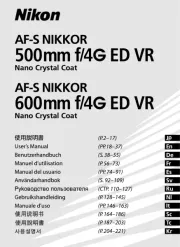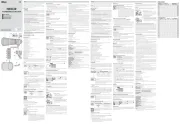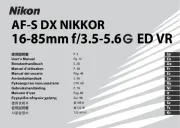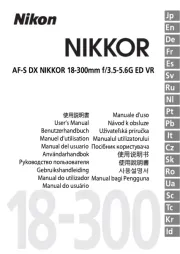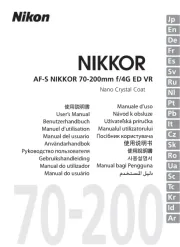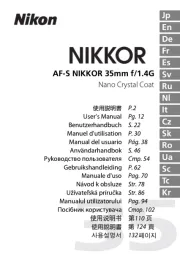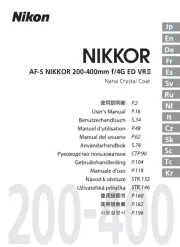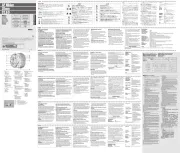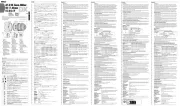
AF-S DX NIKKOR 18–300mm f/3.5–6.3G ED VR
Nous vous remercions d’avoir acheté un objectif DX NIKKOR. Avant d’utiliser ce pro-
duit, veuillez lire attentivement à la fois ces instructions et le manuel de l’appareil
Remarque: les objectifs DX sont destinés aux re ex numériques de format DX,
comme le D7100 ou le D5300. L’angle de champ d’un objectif xé sur un ap-
pareil photo de format DX est égal à environ 1,5 × celui d’un objectif xé sur
un appareil photo 24 × 36 mm.
L’autofocus et le télémètre fonctionnent à toutes les focales. Lorsque vous
utilisez cet objectif, ne tenez pas compte des sections du manuel de l’appareil
photo faisant référence à des restrictions en matière d’autofocus et de télé-
mètre avec une ouverture maximale moins lumineuse que f/5.6.
Pour v
Pour v
Pour v
Pour votre sécurité
otre sécurité
otre sécurité
otre sécuritéPour votre sécurité
A
A
A
ATTENTION
TTENTION
TTENTION
TTENTIONATTENTION
• Ne pas démonter. Toucher les parties internes de l’appareil photo ou de l’objectif
peut provoquer des blessures. En cas de dysfonctionnement, le produit devra
être réparé par un technicien qualifi é uniquement. Si le produit s’ouvre à cause
d’une chute ou de tout autre accident, retirez l’accumulateur de l’appareil
photo et/ou débranchez l’adaptateur secteur et confi ez le produit à un centre
Nikon agréé pour le faire vérifi er.
• Mettre immédiatement l’appareil hors tension en cas de dysfonctionnement
détectez de la fumée ou une odeur inhabituelle provenant de l’équipement,
débranchez immédiatement l’adaptateur secteur et retirez l’accumulateur de
l’appareil photo, tout en prenant soin de ne pas vous brûler. Poursuivre son
utilisation peut provoquer un incendie ou des blessures. Après avoir retiré
l’accumulateur, confi ez l’équipement à un centre Nikon agréé pour le faire vérifi er.
• Ne pas utiliser en présence de gaz in ammable
L’utilisation d’équipement électronique
en présence d’un gaz infl ammable peut provoquer une explosion ou un incendie.
• Ne pas regarder le soleil avec l’objectif ou le viseur de l’appareil photo. Regarder le
soleil ou toute autre source lumineuse intense avec l’objectif ou le viseur peut
provoquer des troubles de la vision irréversibles.
• Tenir éloigné des enfants. Le non-respect de cette précaution peut provoquer des
• Suivre les précautions ci-dessous lors de la manipulation de l’objectif et de l’appareil photo :
-Maintenez l’objectif et l’appareil photo propres. Le non-respect de cette
consigne de sécurité peut endommager le produit, déclencher un feu ou
-Ne pas manipuler l’objectif ou l’appareil photo avec des mains mouillées. Le
non-respect de cette précaution peut provoquer un choc électrique.
-Ne pas inclure le soleil dans le cadrage lors de la prise de vue de sujets
en contre-jour. La concentration de la lumière du soleil dans l’appareil
photo lorsque le soleil est dans ou à proximité du champ de l’image peut
-Si vous n’avez pas l’intention d’utiliser l’objectif pendant une période
prolongée, fi xez les bouchons avant et arrière et rangez l’objectif hors de
la lumière directe du soleil. Si l’objectif est laissé en contact direct avec la
lumière du soleil, les rayons peuvent toucher des objets infl ammables, et
• Ne pas transporter un trépied avec un objectif ou un appareil photo xé dessus. Vous
risqueriez de trébucher ou de frapper accidentellement des personnes,
provoquant ainsi des blessures.
• Ne laissez pas ce produit exposé à des températures excessivement chaudes, comme dans
une voiture fermée ou en plein soleil. Vous risqueriez d’endommager le matériel ou
de provoquer un incendie.
Avis pour les Clien
Avis pour les Clien
Avis pour les Clien
Avis pour les Clients au Canada
ts au Canada
ts au Canada
ts au CanadaAvis pour les Clients au Canada
Parties de l
Parties de l
Parties de l
Parties de l’
’
’
’objec
objec
objec
objectif (
tif (
tif (
tif (
Repère de verrouillage du parasoleil
Repère d’alignement du parasoleil
Repère de montage du parasoleil
Repère de l’échelle des focales
Repère de montage de l’objectif
Joint en caoutchouc de la monture d’objectif
Contacts du microprocesseur
Commutateur de verrouillage du zoom
Commutateur ON/OFF de réduction de vibration
Mise au point
Mise au point
Mise au point
Mise au pointMise au point
Le mode de mise au point est déterminé par le mode de mise au point de l’appareil
photo et la position du commutateur de mode A-M de l’objectif. Reportez-vous au
manuel de l’appareil photo pour plus d’informations sur la sélection du mode de
mise au point de l’appareil photo.
Mode de mise au point de
Mode de mise au point de
Mode de mise au point de
Mode de mise au point de Mode de mise au point de
l
l
l
l’
’
’
’appareil photo
appareil photo
appareil photo
appareil photol’appareil photo
Mode de mise au point de l
Mode de mise au point de l
Mode de mise au point de l
Mode de mise au point de l’
’
’
’objectif
objectif
objectif
objectifMode de mise au point de l’objectif
Mise au point manuelle avec
* Disponible uniquement lorsque AF ponctuel (AF-S) est sélectionné comme
mode de mise au point sur l’appareil photo.
Autofocus
Autofocus
Autofocus
AutofocusAutofocus
Réglez l’appareil photo sur AF (autofocus).
Positionnez le commutateur de mode A-M de l’objectif sur A.
Eff ectuez la mise au point.
Appuyez sur le déclencheur à mi-course pour e ectuer la mise au
point. En mode AF ponctuel (AF-S), vous pouvez ajuster la mise au
point en maintenant le déclencheur appuyé à mi-course une fois
l’opération d’autofocus terminée et en tournant manuellement la
bague de mise au point. Ne tournez pas la bague de mise au point
tant que l’opération d’autofocus n’est pas terminée. Pour refaire le
point à l’aide de l’autofocus, appuyez à nouveau sur le déclencheur
à mi-course ou sur la commande AF-ON.
Mise au point manuelle
Mise au point manuelle
Mise au point manuelle
Mise au point manuelle
Positionnez le commutateur de mode A-M de l’objectif sur M.
Eff ectuez la mise au point.
Effectuez la mise au point manuellement en utilisant la bague de
mise au point de l’objectif.
Re
Re
Re
Remar
mar
mar
marque
que
que
que r
r
r
rela
ela
ela
elati
ti
ti
tiv
v
v
ve
e
e
e aux
aux
aux
aux
ob
ob
ob
obj
j
j
ject
ect
ect
ectifs
ifs
ifs
ifs
gr
gr
gr
grand
and
and
and-an
-an
-an
-angl
gl
gl
gle e
e e
e e
e et u
t u
t u
t ul
l
l
ltr
tr
tr
tra g
a g
a g
a gr
r
r
ra
a
a
and
nd
nd
nd-
-
-
-an
an
an
angl
gl
gl
gle
e
e
e
Remarque relative aux objectifs grand-angle et ultra grand-angle
L’autofocus risque de ne pas produire les résultats escomptés dans des situations
semblables à celles décrites ci-dessous. Dans ce cas, eff ectuez la mise au point ma-
nuellement ou mémorisez-la pour mettre au point un autre sujet situé à la même
distance, puis recomposer la photo.
Les objets de l’arrière-plan occupent une plus grande
partie du point AF que le sujet principal : si le point
AF contient à la fois des objets du premier plan et
de l’arrière-plan, l’appareil photo peut eff ectuer la
mise au point sur l’arrière-plan et par conséquent,
le sujet risque d’être fl ou.
Le sujet contient trop de petits détails : l’appareil
photo risque d’avoir des diffi cultés à faire le point
sur des sujets manquant de contraste ou qui
paraissent plus petits que les objets de l’arrière-
Pour plus d’informations, reportez-vous à la section « Optimisation des résul-
tats avec l’autofocus » dans le manuel de l’appareil photo.
Zoom et profondeur de champ
Zoom et profondeur de champ
Zoom et profondeur de champ
Zoom et profondeur de champ Zoom et profondeur de champ
Avant de faire la mise au point, tournez la bague de zoom pour régler la focale et ca-
drer la photographie. Si l’appareil photo off re un aperçu de la profondeur de champ
(fermeture du diaphragme), il est possible d’avoir un aperçu de la profondeur de
Pour verrouiller la bague de zoom, placez-la sur 18 mm et positionnez le com-
mutateur de verrouillage du zoom sur LOCK. Cela permet d’éviter que l’objectif
ne sorte, entraîné par son propre poids, lors du transport de l’appareil photo.
Ouverture
Ouverture
Ouverture
OuvertureOuverture
Pour régler l’ouverture, utilisez les commandes de l’appareil photo.
Zoom et ouverture maximale
Zoom et ouverture maximale
Zoom et ouverture maximale
Zoom et ouverture maximaleZoom et ouverture maximale
Modifi er le zoom peut altérer l’ouverture maximale jusqu’à 1⁄L. L’appareil photo
prend cela automatiquement en compte lors du réglage de l’exposition et aucune
modifi cation des réglages de l’appareil photo n’est nécessaire après les ajustements
Flash intégré
Flash intégré
Flash intégré
Flash intégré
Lors de l’utilisation du fl ash intégré (pour les appareils photo équipés d’un fl ash in-
tégré), photographiez à des distances de 0,6 m ou plus et retirez le parasoleil pour
éviter l’eff et de vignettage (ombres créées lorsque l’extrémité de l’objectif occulte le
Appareil photo
Appareil photo
Appareil photo
Appareil photoAppareil photo
Focale
Focale
Focale
FocaleFocale
Utiliser à des distances de
Utiliser à des distances de
Utiliser à des distances de
Utiliser à des distances deUtiliser à des distances de
Gamme D300/D100
Gamme D300/D100
Gamme D300/D100
Gamme D300/D100Gamme D300/D100
35 mm ou plus Aucune restriction
D5300/D5200/D5100/D5000/
D5300/D5200/D5100/D5000/
D5300/D5200/D5100/D5000/
D5300/D5200/D5100/D5000/D5300/D5200/D5100/D5000/
D3300/D3200/D3100/D3000/D80/
D3300/D3200/D3100/D3000/D80/
D3300/D3200/D3100/D3000/D80/
D3300/D3200/D3100/D3000/D80/D3300/D3200/D3100/D3000/D80/
gamme D70/D60/D50/
gamme D70/D60/D50/
gamme D70/D60/D50/
gamme D70/D60/D50/gamme D70/D60/D50/
gamme D40
gamme D40
gamme D40
gamme D40 gamme D40
35 mm ou plus Aucune restriction
Le fl ash intégré du D100 peut être utilisé à des focales égales ou supérieures à 20 mm.
Un phénomène de vignettage est visible à une focale de 18 mm.
Réduction de vibration (VR)
Réduction de vibration (VR)
Réduction de vibration (VR)
Réduction de vibration (VR)Réduction de vibration (VR)
La fonction de réduction de vibration (VR) atténue les phénomènes de fl ou provo-
qués par le bougé de l’appareil photo, ce qui permet de recourir à des vitesses d’obtu-
ration jusqu’à 4,0 fois plus lentes que celles normalement utilisées*. Cela augmente la
plage des vitesses d’obturation disponibles et permet de prendre des photos à main
levée, sans trépied, dans de nombreuses situations.
* Mesures effectuées à 300 mm avec un appareil photo de format DX selon
les normes de la CIPA (Camera and I P Amaging roducts ssociation) ; les effets
varient selon le photographe et les conditions de prise de vue.
Utilisation du commuta
Utilisation du commuta
Utilisation du commuta
Utilisation du commutateur ON/OFF pour la réduction de vibration
teur ON/OFF pour la réduction de vibration
teur ON/OFF pour la réduction de vibration
teur ON/OFF pour la réduction de vibration
Utilisation du commutateur ON/OFF pour la réduction de vibration
• Sélectionnez ON (ACTIVÉ) pour activer la réduction de vibration. La
réduction de vibration est activée lorsque vous appuyez à mi-
course sur le déclencheur, réduisant ainsi les effets du bougé
d’appareil pour vous permettre d’améliorer le cadrage et la
• Sélectionnez OFF (DÉSACTIVÉ) pour désactiver la réduction de
Utiliser la réduction de vibra
Utiliser la réduction de vibra
Utiliser la réduction de vibra
Utiliser la réduction de vibration : remarques
tion : remarques
tion : remarques
tion : remarquesUtiliser la réduction de vibration : remarques
• Lorsque vous utilisez la réduction de vibration, appuyez sur le déclencheur à
mi-course et attendez que l’image se stabilise dans le viseur avant d’appuyer
sur le déclencheur jusqu’en fi n de course.
• Lorsque la réduction de vibration est activée, l’image dans le viseur peut être
fl oue une fois le déclencheur relâché. Cela n’indique pas un dysfonctionnement.
• Lorsque l’appareil photo est en mode panoramique, la réduction de vibration
s’applique uniquement au mouvement ne faisant pas partie du panoramique
(si l’appareil photo est en mode panoramique horizontal par exemple, la
réduction de vibration s’applique uniquement au mouvement vertical), Vous
pouvez ainsi faire plus facilement un panoramique régulier en un arc large.
• Ne mettez pas l’appareil photo hors tension et ne retirez pas l’objectif pendant
que la réduction de vibration est activée.
• Si l’appareil photo est équipé d’un fl ash intégré, la réduction de vibration est
désactivée pendant que le fl ash se charge.
• Sélectionnez OFF lorsque l’appareil photo est monté sur un trépied sauf si la
tête du trépied n’est pas fi xée ou si l’appareil est monté sur un monopode ;
dans ce cas, est recommandé.ON
Parasoleil optionnel
Parasoleil optionnel
Parasoleil optionnel
Parasoleil optionnel
Le parasoleil protège l’objectif et bloque la lumière diff use pouvant causer de la lu-
mière parasite ou une image fantôme.
Fixation du parasoleil
Fixation du parasoleil
Fixation du parasoleil
Fixation du parasoleilFixation du parasoleil
Alignez le repère de montage du parasoleil
●) sur le repère d’alignement du
parasoleil ( ), puis tournez le parasoleil
) jusqu’à ce que le repère
sur le repère de verrouillage du parasoleil
Lors de la xation ou du retrait du parasoleil, tenez-le près du symbole sur
sa base, et évitez de le serrer trop fermement. Un vignettage peut se produire
si le parasoleil n’est pas correctement attaché.
Le parasoleil peut être retourné et monté sur l’objectif lorsqu’il n’est pas utilisé.
Entretien de l
Entretien de l
Entretien de l
Entretien de l’
’
’
’objec
objec
objec
objectif
tif
tif
tif
• Ne prenez pas ou ne tenez pas l’objectif ou l’appareil photo en saisissant
uniquement le parasoleil.
• Maintenez les contacts du microprocesseur propres.
• Si le joint en caoutchouc de la monture d’objectif est endommagé, cessez
immédiatement l’utilisation et confi ez l’objectif à un centre Nikon agréé pour
• Utilisez une souffl ette pour enlever la poussière et les peluches sur la surface de
l’objectif. Pour eff acer les taches et les traces de doigt, imprégnez un morceau
de tissu propre en coton avec une petite quantité d’éthanol ou de nettoyant
pour objectif ou utilisez une lingette de nettoyage d’objectif, et nettoyez avec
un mouvement circulaire à partir du centre vers l’extérieur, tout en prenant
soin de ne pas laisser de taches, ni de toucher le verre avec vos doigts.
• N’utilisez jamais de solvants organiques comme un diluant à peinture ou du
benzène pour nettoyer l’objectif.
• Le parasoleil ou les fi ltres NC peuvent être utilisés pour protéger la lentille
• Fixez les bouchons avant et arrière avant de placer l’objectif dans son étui.
• Si vous n’avez pas l’intention d’utiliser l’objectif pendant une période
prolongée, rangez-le dans un endroit frais et sec pour éviter la moisissure et
la rouille. Ne le rangez pas à la lumière directe du soleil ou avec des boules
antimites de naphtaline ou de camphre.
• Tenez l’objectif au sec. La formation de rouille sur le mécanisme interne peut
causer des dégâts irréparables.
• Laisser l’objectif dans des endroits extrêmement chauds peut endommager
ou déformer les éléments composés de plastique renforcé.
Acc
Acc
Acc
Accessoires fournis
essoires fournis
essoires fournis
essoires fournisAccessoires fournis
• Bouchon avant d’objectif encliquetable 67 mm LC-67
• Bouchon arrière d’objectif LF-4
Acc
Acc
Acc
Accessoires compatibles
essoires compatibles
essoires compatibles
essoires compatiblesAccessoires compatibles
• Parasoleil à baïonnette HB-39
• Étui souple pour objectif CL-1018
Caractéristiques
Caractéristiques
Caractéristiques
Caractéristiques
Type Objectif AF-S DX de type G avec microprocesseur
Ouverture maximale
Ouverture maximale
Ouverture maximale
Ouverture maximale
Ouverture maximale f/3.5 – 6.3
Construction optique
Construction optique
Construction optique
Construction optique
Construction optique 16 lentilles en 12 groupes (dont 3 lentilles en verre ED et 3
Angle de champ
Angle de champ
Angle de champ
Angle de champAngle de champ
Échelle des focales
Échelle des focales
Échelle des focales
Échelle des focales
Échelle des focales Graduée en millimètres (18, 35, 70, 105, 200, 300)
Information de distance
Information de distance
Information de distance
Information de distance
Information de distance Communiquée au boîtier de l’appareil photo
Zoom Zoom manuel utilisant une bague de zoom
Mise au point
Mise au point
Mise au point
Mise au point
Mise au point Système de mise au point interne de Nikon (IF,
Internal Focusing) avec autofocus commandé par
un moteur ondulatoire silencieux (SWM) et bague
de mise au point pour mise au point manuelle
Réduction de vibration
Réduction de vibration
Réduction de vibration
Réduction de vibration
Réduction de vibration Décentrement avec v c moice oil otors (VCMs)
Distance minimale de mise
Distance minimale de mise
Distance minimale de mise
Distance minimale de mise Distance minimale de mise
au point
au point
au point
au pointau point
0,48 m depuis le plan focal à toutes les focales
Lamelles de diaphragme
Lamelles de diaphragme
Lamelles de diaphragme
Lamelles de diaphragme
Lamelles de diaphragme 7 (diaphragme circulaire)
Diaphragme
Diaphragme
Diaphragme
Diaphragme
Diaphragme Intégralement automatique
Plage des ouvertures
Plage des ouvertures
Plage des ouvertures
Plage des ouvertures
Plage des ouvertures • : f/3.5 à f/22Focale 18 mm
• Focale 300 mm : f/6.3 à f/40
L’ouverture minimale affichée peut varier en
fonction de l’incrément d’exposition sélectionné
Mesure
Mesure
Mesure
MesureMesure
Diamètre de fixation pour
Diamètre de fixation pour
Diamètre de fixation pour
Diamètre de fixation pour Diamètre de fixation pour
filtre
filtre
filtre
filtrefiltre
Dimensions
Dimensions
Dimensions
Dimensions
Dimensions Environ 78,5 mm de diamètre maximum × 99 mm
(distance à partir du plan d’appui de la monture d’objectif de
Nikon se réserve le droit de modifi er les caractéristiques du matériel décrit dans ce
manuel à tout moment et sans préavis.
Thank you for your purchase of a DX NIKKOR lens. Before using this product,
please carefully read both these instructions and the camera manual.
Note: DX lenses are for use with DX-format digital single-lens refl ex cameras
such as the D7100 or D5300. The angle of view of a lens on a DX-format
camera is equivalent to that of a lens with a focal length about 1.5 × longer
mounted on a 35 mm format camera.
Autofocus and rangefi nder features are supported at all focal lengths. When
using this lens, ignore any sections of the camera manual listing autofocus
and rangefi nder restrictions for lenses with a maximum aperture slower
F
F
F
For
or
or
or Y
Y
Y
Your S
our S
our S
our Safety
afety
afety
afetyFor Your Safety
CAUTIONS
CAUTIONS
CAUTIONS
CAUTIONSCAUTIONS
• Do not disassemble. Touching the internal parts of the camera or lens could
result in injury. In the event of malfunction, the product should be re-
paired only by a qualifi ed technician. Should the product break open as
the result of a fall or other accident, remove the camera battery and/or
disconnect the AC adapter and then take the product to a Nikon-autho-
rized service center for inspection.
• Turn the camera o immediately in the event of malfunction. Should you notice
smoke or an unusual smell coming from the equipment, immediately un-
plug the AC adapter and remove the camera battery, taking care to avoid
burns. Continued operation could result in fi re or injury. After removing
the battery, take the equipment to a Nikon-authorized service center for
• Do not use in the presence of ammable gas. Operating electronic equipment
in the presence of fl ammable gas could result in explosion or fi re.
• Do not look at the sun through the lens or the camera view nder. Viewing the sun
or other bright light source through the lens or viewfi nder could cause
permanent visual impairment.
• Keep out of reach of children. Failure to observe this precaution could result
• Observe the following precautions when handling the lens and camera:
-Keep the lens and camera dry. Failure to observe this precaution could
result in damage to the product, fi re, or electric shock.
-Do not handle the lens or camera with wet hands. Failure to observe this
precaution could result in electric shock.
-Keep the sun well out of the frame when shooting backlit subjects. Sun-
light focused into the camera when the sun is in or close to the frame
-If the lens will not be used for an extended period, attach the front and rear
lens caps and store the lens out of direct sunlight. If left in direct sunlight,
the lens could focus the sun’s rays onto fl ammable objects, causing fi re.
• Do not carry tripods with a lens or camera attached. You could trip or acciden-
tally strike others, resulting in injury.
• Do not leave the product where it will be exposed to extremely high temperatures,
such as in an enclosed automobile or in direct sunlight. Failure to observe this
precaution could cause damage or fi re.
Notice for C
Notice for C
Notice for C
Notice for Customers in Canada
ustomers in Canada
ustomers in Canada
ustomers in Canada
Notice for Customers in Canada
Parts of the Lens (Figure)
Parts of the Lens (Figure)
Parts of the Lens (Figure)
Parts of the Lens (Figure)
Parts of the Lens (Figure)
Vibration reduction ON/OFF switch
Focus
Focus
Focus
FocusFocus
Focus mode is determined by the camera focus mode and the position of
the lens A-M mode switch. See the camera manual for information on cam-
era focus mode selection.
Camera focus mode
Camera focus mode
Camera focus mode
Camera focus mode
Lens focus mode
Lens focus mode
Lens focus mode
Lens focus modeLens focus mode
Manual focus with electronic
* Available only when single-servo AF (AF-S) is selected as the camera focus
Autofocus
Autofocus
Autofocus
AutofocusAutofocus
Set the camera to AF (autofocus).
Slide the lens A-M mode switch to .A
Press the shutter-release button halfway to focus. In single-
servo AF (AF-S), focus can be adjusted by keeping the shutter-
release button pressed halfway after the autofocus operation
is complete and manually rotating the focus ring. Do not ro-
tate the focus ring until the autofocus operation is complete.
To refocus using autofocus, press the shutter release button
halfway or press the AF-ON button again.
Manual Focus
Manual Focus
Manual Focus
Manual FocusManual Focus
Slide the lens A-M mode switch to .M
Focus manually using the lens focus ring.
A Note on
A Note on
A Note on
A Note on W
W
W
Wide- and S
ide- and S
ide- and S
ide- and Super W
uper W
uper W
uper Wide
ide
ide
ide-Angle Lenses
-Angle Lenses
-Angle Lenses
-Angle Lenses
A Note on Wide- and Super Wide-Angle Lenses
Autofocus may not provide the desired results in situations like those
shown below. In these cases, use manual focus, or use focus lock to focus on
another subject at the same distance and then recompose the photograph.
Objects in the background occupy more of the
focus point than the main subject:
point contains both foreground and
background objects, the camera may focus on
the background and the subject may be out of
The subject contains many ne details:
camera may have diffi culty focusing on
subjects that lack contrast or appear smaller
than objects in the background.
For more information, see “Getting Good Results with Autofocus” in the
Zoom and Depth of Field
Zoom and Depth of Field
Zoom and Depth of Field
Zoom and Depth of Field Zoom and Depth of Field
Before focusing, rotate the zoom ring to adjust the focal length and frame
the photograph. If the camera off ers depth-of-fi eld preview (stop down),
depth of fi eld can be previewed in the viewfi nder.
To lock the zoom ring, rotate it to the 18 mm position and slide the zoom
lock switch to LOCK. This prevents the lens extending under its own weight
while the camera is being carried from place to place.
Aperture
Aperture
Aperture
Aperture
Aperture is adjusted using camera controls.
Zoom and Maximum Aper
Zoom and Maximum Aper
Zoom and Maximum Aper
Zoom and Maximum Aperture
ture
ture
tureZoom and Maximum Aperture
Changes to zoom can alter the maximum aperture by up to 1⁄ EV. The
camera however automatically takes this into account when setting expo-
sure, and no modifi cations to camera settings are required following adjust-
Built-in Flash Units
Built-in Flash Units
Built-in Flash Units
Built-in Flash UnitsBuilt-in Flash Units
When using the built-in fl ash on cameras equipped with a built-in fl ash
unit, shoot at ranges of 0.6 m (2 ft) or more and remove the lens hood to
prevent vignetting (shadows created where the end of the lens obscures
Camera
Camera
Camera
CameraCamera
Focal length
Focal length
Focal length
Focal lengthFocal length
Use at ranges of
Use at ranges of
Use at ranges of
Use at ranges ofUse at ranges of
D300 series/D100
D300 series/D100
D300 series/D100
D300 series/D100D300 series/D100
18 mm 1.0 m/3 ft 3 in. or more
35 mm or more No restrictions
D5300/D5200/D5100/D5000/
D5300/D5200/D5100/D5000/
D5300/D5200/D5100/D5000/
D5300/D5200/D5100/D5000/D5300/D5200/D5100/D5000/
D3300/D3200/D3100/D3000/D80/
D3300/D3200/D3100/D3000/D80/
D3300/D3200/D3100/D3000/D80/
D3300/D3200/D3100/D3000/D80/D3300/D3200/D3100/D3000/D80/
D70 series/D60/D50/D40 series
D70 series/D60/D50/D40 series
D70 series/D60/D50/D40 series
D70 series/D60/D50/D40 seriesD70 series/D60/D50/D40 series
35 mm or more No restrictions
The built-in fl ash unit on the D100 can be used at focal lengths of 20 mm or
more. Vignetting occurs at a focal length of 18 mm.
Vibr
Vibr
Vibr
Vibration Reduction (
ation Reduction (
ation Reduction (
ation Reduction (VR)
VR)
VR)
VR)Vibration Reduction (VR)
Vibration reduction (VR) reduces blur caused by camera shake, allowing
shutter speeds up to 4.0 stops slower than would otherwise be the case*.
This increases the range of shutter speeds available and permits hand-held,
tripod-free photography in a wide range of situations.
* Measured at 300 mm with a DX-format camera according to Camera and
I P Amaging roducts ssociation [CIPA] standards; eff ects vary with the pho-
tographer and shooting conditions.
Using the Vibration Reduction ON/OFF Switch
Using the Vibration Reduction ON/OFF Switch
Using the Vibration Reduction ON/OFF Switch
Using the Vibration Reduction ON/OFF Switch Using the Vibration Reduction ON/OFF Switch
• Select ON to enable vibration reduction. Vibration reduction is
activated when the shutter-release button is pressed halfway,
reducing the eff ects of camera shake for improved framing
• Select OFF to turn vibration reduction o .
Using Vibration Reduction: Notes
Using Vibration Reduction: Notes
Using Vibration Reduction: Notes
Using Vibration Reduction: Notes Using Vibration Reduction: Notes
• When using vibration reduction, press the shutter-release button halfway
and wait for the image in the viewfi nder to stabilize before pressing the
shutter-release button the rest of the way down.
• When vibration reduction is active, the image in the viewfi nder may be
blurred after the shutter is released. This does not indicate a malfunction.
• When the camera is panned, vibration reduction applies only to motion
that is not part of the pan (if the camera is panned horizontally, for ex-
ample, vibration reduction will be applied only to vertical shake), making
it much easier to pan the camera smoothly in a wide arc.
• Do not turn the camera off or remove the lens while vibration reduction
• If the camera is equipped with a built-in fl ash, vibration reduction will be
disabled while the fl ash charges.
• Select OFF when the camera is mounted on a tripod unless the tripod
head is unsecured or the camera is mounted on a monopod, in which
The Optional Lens Hood
The Optional Lens Hood
The Optional Lens Hood
The Optional Lens Hood The Optional Lens Hood
The lens hoods protect the lens and block stray light that would otherwise
Attaching the Hood
Attaching the Hood
Attaching the Hood
Attaching the HoodAttaching the Hood
Align the lens hood mounting mark
(●) with the lens hood alignment
mark ( ) and then rotate the hood
) until the mark is aligned with ●
the lens hood lock mark (— ).
When attaching or removing the hood, hold it near the
base and avoid gripping it too tightly. Vignetting may occur if the hood is
The hood can be reversed and mounted on the lens when not in use.
Lens Care
Lens Care
Lens Care
Lens Care
• Do not pick up or hold the lens or camera using only the lens hood.
• Keep the CPU contacts clean.
• Should the rubber lens-mount gasket be damaged, cease use immedi-
ately and take the lens to a Nikon-authorized service center for repair.
• Use a blower to remove dust and lint from the lens surfaces. To remove
smudges and fi ngerprints, apply a small amount of ethanol or lens cleaner
to a soft, clean cotton cloth or lens-cleaning tissue and clean from the
center outwards using a circular motion, taking care not to leave smears
or touch the glass with your fi ngers.
• Never use organic solvents such as paint thinner or benzene to clean the lens.
• The lens hood or NC fi lters can be used to protect the front lens element.
• Attach the front and rear caps before placing the lens in its fl exible pouch.
• If the lens will not be used for an extended period, store it in a cool, dry loca-
tion to prevent mold and rust. Do not store in direct sunlight or with naphtha
• Keep the lens dry. Rusting of the internal mechanism can cause irrepa-
• Leaving the lens in extremely hot locations could damage or warp parts
made from reinforced plastic.
Supplied Accessories
Supplied Accessories
Supplied Accessories
Supplied Accessories
• 67 mm snap-on Front Lens Cap LC-67
Compatible A
Compatible A
Compatible A
Compatible Acc
cc
cc
ccessories
essories
essories
essoriesCompatible Accessories
• Flexible Lens Pouch CL-1018
Specifi
Specifi
Specifi
Specifi
cations
cations
cations
cationsSpecifi cations
Type Type G AF-S DX lens with built-in CPU and F mount
Focal length
Focal length
Focal length
Focal length
Maximum aperture
Maximum aperture
Maximum aperture
Maximum aperture
Maximum aperture f/3.5 – 6.3
Lens construction
Lens construction
Lens construction
Lens construction
Lens construction 16 elements in 12 groups (including 3 ED lens elements, 3
aspherical lens elements)
Angle of view
Angle of view
Angle of view
Angle of viewAngle of view
Focal length scale
Focal length scale
Focal length scale
Focal length scale
Focal length scale Graduated in millimeters (18, 35, 70, 105, 200, 300)
Distance information
Distance information
Distance information
Distance information
Distance information Output to camera
Zoom Manual zoom using independent zoom ring
Focusing
Focusing
Focusing
Focusing
Focusing I FNikon nternal ocusing (IF) System with autofocus
controlled by Silent Wave Motor and separate focus
Vibration reduction
Vibration reduction
Vibration reduction
Vibration reduction
Vibration reduction Lens shift using oil otors voice c m (VCMs)
Minimum focus
Minimum focus
Minimum focus
Minimum focus Minimum focus
distance
distance
distance
distancedistance
0.48 m (1.6 ft) from focal plane at all zoom positions
Diaphragm blades
Diaphragm blades
Diaphragm blades
Diaphragm blades
Diaphragm blades 7 (rounded diaphragm opening)
Diaphragm
Diaphragm
Diaphragm
Diaphragm
Diaphragm Fully automatic
Aperture range
Aperture range
Aperture range
Aperture range
Aperture range • 18mm focal length: f/3.5 – 22
• 300mm focal length: f/6.3 – 40
The minimum aperture displayed may vary de-
pending on the size of the exposure increment
selected with the camera.
Metering
Metering
Metering
Metering
Filter-attachment siz
Filter-attachment siz
Filter-attachment siz
Filter-attachment size
e
e
e
Filter-attachment size 67 mm (P = 0.75 mm)
Dimensions
Dimensions
Dimensions
Dimensions
Dimensions Approx. 78.5 mm maximum diameter × 99 mm
(distance from camera lens mount ange)
Weight Approx. 550 g (19.4 oz)
Nikon reserves the right to change the specifi cations of the hardware described
in this manual at any time and without prior notice.
在所有焦距下均支持自动对焦和测距仪功能。使用本镜头时,请忽
请在使用前仔细阅读“安全须知”,并以正确的方法使用。本“安全
须知”中记载了重要的内容,可使您能够安全、正确地使用产品,并
预防对您或他人造成人身伤害或财产损失。请在阅读之后妥善保管,
本节使用以下图示和符号对必须遵守的内容作分类和说明。
在图示中或图示附近标有具体的注意内容(左图之例为当心
在图示中或图示附近标有具体的禁止内容(左图之例为禁止
在图示中或图示附近标有具体的强制执行内容(左图之例为
有关选择照相机对焦模式的信息,请参阅照相机的说明书。
自动对焦操作完成后持续半按快门释放按钮并同时手动旋转对
焦环可调整对焦。自动对焦操作完成之前请勿旋转对焦环。若
要使用自动对焦以重新对焦,请再次半按快门释放按钮或再次
在如下所示的情况下,自动对焦可能无法达到预期效果。在这些情
况下,请使用手动对焦,或使用对焦锁定对焦于相同距离的其他拍
有关详细信息,请参阅照相机说明书中的“利用自动对焦获取良好
对焦之前,请旋转变焦环调整焦距并进行构图。若照相机支持景深
(锁定)。这样可防止照相机从一处移至另一处时镜头在
会自动考虑这个问题,调整变焦后无需修改照相机设定。
当使用配备有一个内置闪光灯组件的照相机上的内置闪光灯时,请
产生渐晕(因镜头末端遮挡内置闪光灯所产生的阴影)。
D
100上的内置闪光灯组件适用于焦距为20mm 或以上时的情况。
在焦距18mm下使用时会产生渐晕。
)可减少照相机震动所引起的模糊,从而使快门速度可比
的范围,从而在很多情况下可以不使用三脚架而进行手持拍摄。
标准所测量 ;效果根据拍摄者和拍摄环境的不同而异。
使用减震时,请先半按快门释放按钮,然后待取景器中的图像稳
启用减震时,取景器中的图像在您释放快门后可能会变得模糊。
当照相机进行转动时,减震仅应用于非转动部分的动作(例如,若
照相机进行水平转动,则减震将仅应用于垂直方向的震动)
减震处于有效状态时,请勿关闭照相机,也不要取下镜头。
若照相机配备有内置闪光灯,闪光灯充电时减震将无法使用。
镜头遮光罩可保护镜头并阻挡可能导致杂光或鬼影的散射光线。
)与镜头
遮光罩对齐标记( )对齐,然后旋
转遮光罩(
免握得太紧。若未正确安装好遮光罩,则可能会产生渐晕。
若镜头卡口橡胶垫圈损坏,请立即停止使用并将镜头送至尼康授
用吹气球去除镜头表面的灰尘和浮屑。若要去除污点和指纹,可
使用一块滴有少许乙醇或镜头清洁剂的干净软棉布或镜头清洁
纸,以圆周运动方式从里向外进行清洁。注意不要留下污渍,也
若在较长时间内不使用镜头,请将其存放在阴凉干燥的地方以防
止发霉和生锈。切不可存放在直射阳光下,也不可与石脑油或樟
将镜头放置在过于炎热的地方将会使强化塑料部件受损或变形。
运输产品时,请在包装箱内装入足够多的缓冲材料,以减少(避
尼康公司保留可随时更改说明书内载之硬件技术规格的权利,而无
须事先通知。
